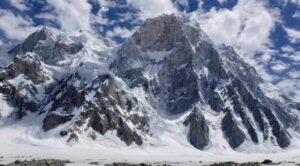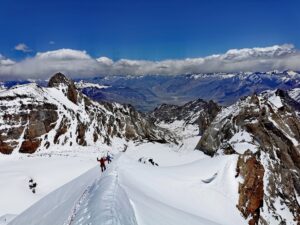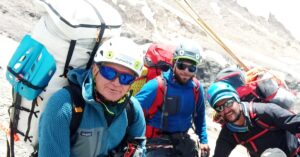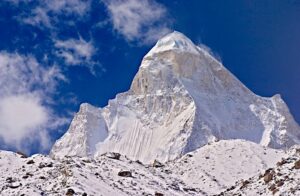Makalu, the world’s fifth-highest mountain at 8,481m, has two notable subsidiary peaks: 7,678m Kangchungtse and 7,804m Chomo Lonzo. Let’s look at Kangchungtse’s climbing history, and in particular, two expeditions from the autumn of 1985.
Makalu and its subsidiary peaks
French climbers Jean Couzy and Lionel Terray made the first ascent of Makalu on May 15, 1955. Both used supplementary oxygen. The first climb without bottled oxygen was on Oct. 6, 1975, by Slovenian Marjan Manfreda.
Since its first ascent, Makalu has a total of 647 summiters, 253 of them without O2. Forty-eight climbers have perished on its slopes, with the most recent fatality in 2019.
Kangchungtse stands about three kilometers north-northwest of Makalu, on the Tibet-Nepal border. Chomo Lonzo, the other secondary peak, is five kilometers north-northeast of Makalu, connected to Kangchungtse by a narrow saddle at 7,200m.
A French team led by Jean Franco first climbed both Chomo Lonzo and Kangchungtse in October 1954. Their initial objective was the first ascent of Makalu, but when they could not push for the summit, they switched their focus. Couzy and Terray were among the summiters.
Chomo Lonzo’s second ascent came 39 years later by a Japanese team. Chomo Lonzo itself has two secondary peaks, but mountaineers rarely frequent the central and north summits.

Makalu from Everest. Chomo Lonzo on the left and Kangchungtse in the centre. Photo: Caingram
Kangchungtse
The New Zealand Alpine Club’s Barun Valley Expedition first attempted Kangchungtse in the spring of 1954. Led by Edmund Hillary, they climbed the north face but retreated at 7,000m after Hillary began to suffer from Acute Mountain Sickness.

Chomo Lonzo 7,804m. Photo: Caingram
The first ascent of Kangchungtse came later that same year. On Oct. 22, 1954, Jean Franco and Lionel Terray of France, along with Gyaltsen Norbu Sherpa from India and Pa Norbu Sherpa from Nepal, topped out via a Makalu La-South Ridge route.
Kangchungtse has had 79 more ascents since then, most recently by Marko Prezelj and Vince Anderson in October 2008. All proceeded without O2.
A total of 13 climbers have died on its slopes, which makes it a fairly dangerous peak when comparing deaths to successful ascents. Its death ratio of 16.25% is substantially higher than Makalu’s 7.41%. However, Makalu’s status as a commercial peak, where most climbers use bottled oxygen, makes these statistics hard to compare.

Kangchungtse, also known as Makalu II. Photo: Caingram
Kangchungtse 1985
In 1985, three parties targeted Kangchungtse. A five-man French group led by Richard Jessup went up the normal route. Three of them — Jessup, Pierre de Montgolfier, and Jean-Francois Porret — reached the top on April 22.
The other two teams decided to climb in the autumn of that year. But that autumn was challenging, characterized by long spells of very bad weather.
The first party to arrive was a Dutch team led by Ronald Naar. Ten Dutch climbers, plus Ang Pasang Sherpa and Nawang Thile Sherpa, made their approach by the Shipton Pass and reached base camp on Sept. 24. They established camp at 5,400m. Ominously, even during the approach, they experienced just one sunny day.
After they reached base camp, the weather remained stable for a week before it turned. “Hard winds, mist, snowfall,” Naar wrote in his report. Despite the dreadful weather, they established the lower camps.

Ronald Naar. Photo: Volkskrant NL
All or nothing
They began their summit push for Oct. 6. But the weather did not abate. Naar reported snowstorms and sometimes complete whiteouts during the ascent. On Oct. 10, at Camp 3, one of the tents blew away and another was completely destroyed.
The next day, during a short period of good visibility, they found the route to the summit. On Oct. 11, Naar, Nawang Thile, Wim Teeuwisse, and Evert Wesker topped out on Kangchungtse. Two days later, Frank Merjenberg and Ang Pasang Sherpa also summited. Later the same day, the last two members reached the top.
They dismantled their higher camps, and the following day, the party left base camp.

Two mountaineers at the Sherpani Col (6,180m). Photo: Summit Travel
An unexpected fatality
After the successful ascent of Kangchungtse, two of the climbers decided to head back to Lukla by an alternative route. Merjenberg and Walter Roos chose to go back via the Sherpani Col (6,180m), West Col (6,135m), and Amphu Laptsa (5,845m).
However, one day after leaving base camp, an unusually severe storm broke out and trapped Merjenberg and Roos below Sherpani Col. They were alone and only had enough food for three days. “They suffocated to death when their tents collapsed under the weight of three meters of new snow,” the Himalayan Database reported.
According to the Himalayan Database, in May 1986, a trekking party led by Richard Salisbury found the bodies of the two Dutch climbers. “The bodies were buried in a collapsed tent on the Barun side of Sherpani Col at about 5,500m,” the report states.
“This accident placed our successful expedition under a dark and bitter shadow,” Naar recalled.

A climber mounts the Sherpani Col Pass. Photo: Visit Himalaya Treks
The other team
A 10-member French team reached the base camp of Kangchungtse on October 16, 1985, led by Pierre Demolombe. They targeted the same west face-south ridge route.
Four members made a first summit bid on November 1. Two climbers reached Makalu La at 7,450m, while the other two remained 100m below. The weather deteriorated later, with more than 170kmph winds and bad snow quality on the 55° slope. The four climbers decided to turn back to camp 3 located at 6,700m. During the night their tents were broken by the harsh weather and icefall.
The next day, November 2, Demolombe and Marcel Margaine did not want to give up. While their partners descended, they made another summit attempt. They were never seen again.
The surviving members left base camp on November 9, while the cook, the kitchen boy, and two porters stayed near the mountain to continue the search. A helicopter search was unsuccessful and it remains a mystery whether Demolombe and Margaine summited Kangchungtse.

The difficult route up to Makalu La. Photo: Everest2012
Four months later, during an attempt on Makalu in February 1986, Reinhold Messner and Hans Kammerlander found two bodies. One was near Makalu La and the other one below it, at 7,450m and 7,100m respectively.
Messner believed these were the remains of the two French climbers. A phone conversation with someone close to Demolombe, in which Messner described his clothing, also suggested a match with the French mountaineer.
“I have a feeling that they did reach the summit before they died. It looked as though Demolombe died of exhaustion and froze near Makalu La, the other man tried to make it down alone and failed,” Messner wrote for The Himalayan Database.






